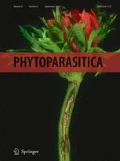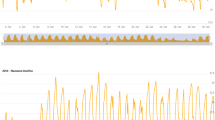Abstract
Eight experimental trials have been carried out under controlled conditions in order to have a better understanding of the effect of temperature and leaf wetness duration on the incidence and severity of leaf spot caused by Fusarium equiseti on lettuce cv. Elisa and wild rocket cv. Grazia. Lettuce resulted very susceptible to F. equiseti, particularly at temperatures of 25–30 °C, with a higher disease index than 50% and a higher disease severity than 25%. At such temperatures, 1–3 h of leaf wetness were sufficient to cause a high disease incidence and severity, while at least 12 h of leaf wetness were necessary to cause high losses at lower temperatures. Disease incidence and severity were higher on the wild rocket at the highest temperatures (30–35 °C). Only one hour of leaf wetness was sufficient to cause significant levels of disease incidence and severity at the highest temperatures, while longer periods (6–12 h) were necessary to cause significant losses at lower temperatures. The possible causes of the recent spread of F. equiseti in northern Italy on a number of crops as well as the threat represented by such a pathogen are discussed hereafter.






Similar content being viewed by others
References
Adams, G. C., Gubler, W. D., & Grogan, R. G. (1987). Seedling disease of muskmelon and mixed melons in California caused by Fusarium equiseti. Plant Disease, 71, 370–374.
Aighe, S. O., & Favole, B. (1999). A cowpea seed rot disease caused by Fusarium equiseti identified in Nigeria. Plant Disease, 83, 964.
Booth, V. (1978). Fusarium equiseti. In: IMI description of fungi and bacteria. CABI Biosciences, Surrey, UK, No. 58, Sheet 571.
Bosch, U., & Mirocha, C. J. (1992). Toxin production by Fusarium species from sugar-beets and natural occurrence of zearaenone in beets and beet fiber. Applied Environmental Microbioogy, 58, 3233–3239.
Bottalico, A. (1988). Fusarium diseases of cereals: species complex and related mycotoxin profiles in Europe. Journal of Plant Pathology, 80, 85–103.
Bottalico, A., & Perrone, G. (2002). Toxigenic Fusarium species and mycotoxins associated with head blight in small-grain cereals in Europe. European Journal Plant Pathology, 108, 611–624.
Chimbekujwo, I. B. (2000). Frequency and pathogenicity of fusarium wilts (Fusarium solani and Fusarium equiseti) of cotton (Gossypium hirsutum) in Adamawa in Nigeria. Revista de Biología Tropical, 48, 1–5.
Elmer, W. H. (1996). Fusarium fruit rot of pumpkin in Connecticut. Plant Disease, 80, 131–135.
Farr, D. F., & Rossman, A.Y. (2016). Fungal databases - Syst. Mycol. Microbiol. Lab. ARS, USDA. Retrieved from http://nt.ars-grin.gov/fungaldatabases.
Garibaldi, A., Gilardi, G., Bertoldo, C., & Gullino, M. L. (2011). First report of leaf spot of rocket (Eruca sativa) caused by Fusarium equiseti in Italy. Plant Disease, 95, 1315.
Garibaldi, A., Gilardi, G., Ortu, G., & Gullino, M. L. (2015). First report of leaf spot of wild rocket (Diplotaxis tenuifolia) caused by Fusarium equiseti in Italy. Plant Disease, 99, 1183.
Garibaldi, A., Gilardi, G., Ortu, G., & Gullino, M. L. (2016). First report of leaf spot of lettuce (Lactuca sativa) caused by Fusarium equiseti in Italy. Plant Disease, 100, 531.
Goswami, R. S., Dong, Y., & Punja, Z. K. (2008). Host range and mycotoxin production by Fusarium equiseti isolates originating from ginseng fields. Canadian Journal Plant Pathology, 30, 155–160.
Kosiak, E. B., Holst-Jensen, A., Rundberget, T., Gonzalez Jaen, M. T., & Torp, M. (2005). Morphological, chemical and molecular differentiation of Fusarium equiseti from Norwegian cereals. International Journal of Food Microbiology, 99, 195–206.
Jimenez, M., Huerta, T., & Mateo, R. (1997). Mycotoxin production by Fusarium species isolated from bananas. Applied Environmetal Microbiology, 63, 364–369.
Punja, Z. K. (1997). Fungal pathogens of American ginseng (Panax quinquefolia L.) in British Columbia. Canadian Journal of Plant Pathology, 19, 301–306.
Punja, Z. K., Wan, A., Rahman, M., Goswami, R. S., Barasubiye, T., Seifert, K. A., & Lèvesque, C. A. (2008). Growth, population dynamics, and diversity of Fusarium equiseti in ginseng fields. European Journal of Plant Pathology, 121, 173–184.
Rai, R. P. (1979). Fusarium equiseti (Corda) Sacc causing dry rot of potato tubers. New report. Current Science, 48, 1043–1045.
Reuveni, R. (1982). Fusarium equiseti. A new cause of cumin spice plant wilt in Israel. Plant Disease, 66, 498–499.
Stepien, L., Koczik, G., & Waskiewicz, A. (2013). Diversity of Fusarium species and mycotoxins contaminating pineapple. Journal of Applied Genetics, 54, 367–380.
Vujanovic, V., Hamel, C., Yergeau, E., & St-Arnaud, M. (2006). Biodiversity and biogeography of Fusarium species from northeastern North American asparagus fields based on microbiological and molecular approaches. Microbial Ecology, 51, 242–255.
Acknowledgements
This project has received funding from the EU Horizon 2020 research and innovation programme under grant agreement No. 633999 (EMPHASIS). The authors would like to thank Marguerite Jones for the language revision.
Author information
Authors and Affiliations
Corresponding author
Rights and permissions
About this article
Cite this article
Garibaldi, A., Gilardi, G., Berta, F. et al. Temperature and leaf wetness affect the severity of leaf spot on lettuce and wild rocket incited by Fusarium equiseti . Phytoparasitica 44, 681–687 (2016). https://doi.org/10.1007/s12600-016-0559-5
Received:
Accepted:
Published:
Issue Date:
DOI: https://doi.org/10.1007/s12600-016-0559-5




